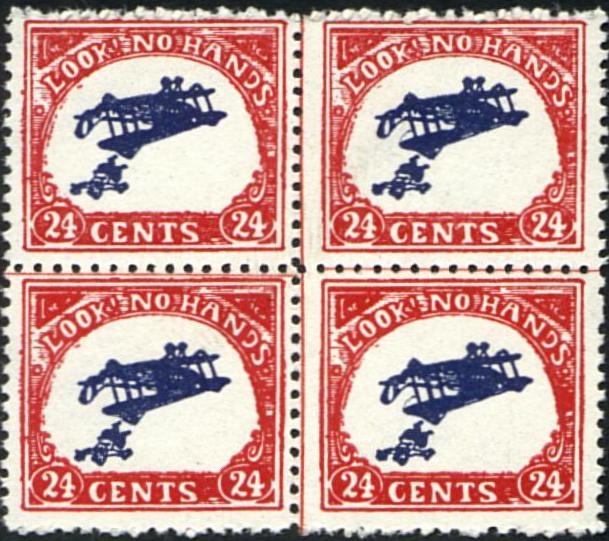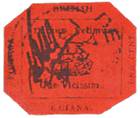

I is for Invert Error |

|

|

|

|
An Invert Error is a production error (see my EFO's page for more about Errors, Freaks, and Oddities) in which one part of a stamp's design is printed upside-down. Such blunders should be caught and destroyed during printing, but occasionally they slip out, and become highly sought-after rarities. The most famous and valuable example is the Inverted Jenny, which occurred on the first US airmail stamp in 1918. The central image - of a Curtiss Jenny biplane - is upside-down! Other well-known (or notorious) examples in the US include the Hammarskj ld Invert (which, once discovered, was reprinted intentionally by the Post Office, in order to destroy the value of the true errors that had slipped out), the CIA invert (so-called because it was a group of CIA employees who discovered it, and subsequently lost their jobs for having appropriated the stamps for their private profit), and most recently the Nixon Invert (which turned out to be printers waste smuggled out of the printing facility by an employee, hence contraband – all copies have been tracked down and confiscated by Postal Inspectors).
Click on any image below to view a high-res version
Below are examples of most of the US invert errors to date, plus one Canadian example.
There
are many more inverts from postal issues of the rest of the world. In 2002
Shreves Philatelic
Galleries held its sale of the fabulous Peter Balner Collection of Inverted
Centers of the World in NYC. This was a once-in-a-lifetime
opportunity to see so many famous inverts at one time. The entire auction catalog, with
every lot illustrated, is still online at http://stampauctionnetwork.com/f/f52.cfm. Oddly, the sale did NOT
include an inverted Jenny, and there are probably other omissions, but it is still an
incomparable offering.
Inverted Jenny - World's Most Famous Invert

Scott C3a, issued May 14, 1918
When the US issued its first Air Mail stamp, on May 14, 1918, collectors were on the lookout for invert errors. This was only the third time the US had issued bicolored stamps, and each of the prior instances had yielded inverts. W.T. Robey was one such collector, who actually went to all his local post offices to look for inverts the day the stamp was first available, and hit the jackpot, finding and buying the only known sheet of 100 copies of the invert (center-line block of four shown above). He sold it a week later for $15,000, a fortune in those days. There's a fascinating book called The Inverted Jenny: Money, Mystery, Mania, by George Amick, that tells the story of this sheet of stamps. As the world's best-known and most sought invert error, its catalog value is currently (2019) $850,000 per stamp, in MNH condition. The block above, the unique center-line block, catalogs $2,100,000!
Note that the catalog value of a single Inverted Jenny hinged is only
$450,000 🙁, illustrating Warren Buffett's observation that the most valuable substance on the planet is the
gum on a postage stamp 🙂.
"Imitation is the sincerest form of flattery", as they say. The image above shows a parody of the Inverted Jenny - "LOOK! NO HANDS".
If you want to read a little more about the Inverted Jenny here is a concise, well-written version of the whole story.
And there's always Wikipedia - Click here.
The Jenny Locket
The man who bought the Inverted Jenny sheet from Robey, Colonel Green, broke it down and sold most of it off over the years, but had one stamp encased in a locket for his wife. The Siegel Auction Galleries Rarities sale of May 18, 2002 included that locket, on the open market for the first time since its creation. Below is a scan of the locket, from the auction catalog:Here is the text from the auction listing:
That, as Sam Spade said in The Maltese Falcon, is "the stuff dreams are made of."24c Carmine Rose & Blue, Center Inverted (C3a) Contained in Mabel Green's Legendary Locket. Position 9 from the top row with wide natural straight edge at top, rich colors on bright fresh paper, placed back to back with normal 24c 1918 Air Post (C3), held between circular glass disks secured in a gold-metal frame with clasp at top, the Inverted Jenny has two trivial corner creases at bottom from rim of pendant, small chip in edge of glass
THE LEGENDARY "LOCKET COPY" OF THE INVERTED JENNY. PRESENTED AS A GIFT BY COLONEL EDWARD H. R. GREEN TO HIS WIFE, MABEL, SOON AFTER THE DISCOVERY AND ACQUISITION OF THE ONLY KNOWN SHEET OF PHILATELY'S MOST FAMOUS ERROR. OFFERED TO THE MARKET FOR THE FIRST TIME SINCE ITS CREATION.
Presented here is the pendant containing a 24c Inverted Jenny, given by Colonel Edward H. R. Green to his wife, Mabel. The pendant is made of two round pieces of glass with a gold rim and clasp for a chain. Sandwiched between the glass is the Inverted Jenny back to back with a normal 24c stamp. The Inverted Jenny comes from Position 9 in the top row of the original pane of 100. It has a natural straight edge at top. The bottom corners were slightly creased when the stamp was placed in the locket.
The recipient of Colonel Green's largesse was his longtime companion, Mabel E. Harlow, who became Mrs. Green in 1916, only months after the death of Edward's mother, Hetty Green. Hetty Green is still remembered in unkind terms as the "Witch of Wall Street" and the "World's Greatest Miser". There is a Hetty Green Historical Society devoted to the story of her remarkable life. Hetty was descended from the Howland and Robinson families, whose fortunes were made in the 19th century New Bedford whaling industry. Hetty inherited millions of dollars as a young woman and devoted her life to shrewd investing and bare-knuckled negotiations. She became one of the wealthiest individuals in the world. Hetty also became infamous for her excessive frugality. It was Hetty's unwillingness to spend money on proper medical treatment that led to the amputation of her teen-age son Edward's left leg. He spent the rest of his life hobbling on a cork prosthetic leg.
When Hetty died at age 81 in June 1916, her estate was variously estimated to be worth between $80 million and $200 million. Hetty's vast assets were divided equally between Edward and his sister, Sylvia. While Sylvia continued her quiet and relatively modest lifestyle, it was Edward, freed from his mother's domination, who went on a massive spending spree. He was also free to marry Mabel Harlow, whom his mother had referred to as "Miss Harlot". Mabel and Edward met in Chicago 24 years earlier when she was practicing her trade as an exotic dancer and prostitute. She left the smitten Edward to marry another man. Some time later, Edward and Mabel reunited in Texas, and he hired the voluptuous redhead to be his "housekeeper" on a more permanent basis.
During the years Edward and Mabel were together, he lavished gifts on her. In fact, the Inverted Jenny locket was a relatively modest gift. When they were together in Texas, the Colonel -- a title granted to him by the governor -- had a custom Pullman railroad car embellished with Mabel's name. Soon after the two married, the Colonel gave Mabel a $50,000 diamond-studded chastity belt. It is unlikely that Mabel wore either the belt or the Locket Copy. When the Greens decided to travel to Florida in 1924, they occupied two private railroad cars to transport the Colonel, his masseuse, valet, chauffeur, stamp and coin secretaries, Mabel and her girl companion, their personal maids and a half-dozen of Edward's so-called "protegees".
The Colonel collected stamps in similarly bold manner. He would acquire entire collections intact, including the J. K. Storrow collection of U.S., which cost $77,500 and would probably be worth millions today. His visits to New York City's Nassau Street stamp district were legendary. He would sit in a chauffeured limousine with his artificial leg propped up. Dealers would bring him their offerings, and he would pay in cash. His stamp and coin collections were organized by a corps of young women who called their affectionate employer "Uncle Ned".
When the Colonel died in 1936, his estate became the focus of multi-state battle over death taxes. Four different states claimed that the Colonel was a resident, a problem created by Green lifetime effort to claim residence in Texas while living in other places. After four million words of testimony and 2,855 exhibits, the Supreme Court ultimately decided in favor of Massachusetts, which received $5,250,000 in taxes. The Colonel left his estate to his sister, Sylvia Wilks, who simply added the $30 million to her non-interest bearing checking account at Chase National. His stamp collection was dispersed in a series of 28 auctions over four years, comprising some 50,000 lots. Mabel filed a claim against the estate, despite the agreement she had signed before marriage, and it was quietly settled. Mabel kept her Inverted Jenny locket and left it to a trusted companion when she died in 1950. In George Amick's book Jenny!, he tells the story of the Locket Copy. Amick was allowed by the owner to photograph it at the Bank of New York.
The 2002 Scott Catalogue value for a C3a is $170,000.00 hinged and $200,000.00. It is unlikely that the gum on this example has ever been hinged, and it appears (without opening the pendant) that the stamp and gum are in excellent condition.
LATER - the locket failed to sell in that 2002 auction, presumably because no
bids exceeded the reserve,
but
was sold on May 20, 2015 in a private treaty sale, for $140,000 plus a $24,500 ( 17.5 percent) buyer's premium.
The Beat Goes On!
2/28/2007 - The Inverted Jenny continues to make the headlines. Two recent stories show the amazing fame and appeal of this super-star of stamps.
1. In October of 2005, the unique plate block of four of the Inverted Jenny sold at a New York auction, to an anonymous bidder, for nearly $3 million. That was a record, but the philatelic world was floored two weeks later when the buyer of the famous block traded it for one of the only two known copies of the equally famous "Z Grill." Read the full story HERE And just to give some perspective to that trade, the last time the plate block sold, in 1989, it brought $1.1 million, and the last time the Z Grill sold, in 1998, it went for $935,000, which many at the time thought was a ridiculous price. Who's laughing now?
2. In November of 2006, an absentee ballot mailed to a Florida elections office had what looked like an Inverted Jenny on it as postage! An election offficial with some philatelic background spotted it and alerted the media. Chaos ensued. It turned out to be a fake, but what fun it was for a few weeks, imagining how a real Inverted Jenny could have wound up on that envelope, and how upset the owner must be, thinking he'd lost it, then finding he'd diminshed its value by at least half. Read all about that HERE. Now I want to know Who created the fake, amd Why did they put it on that ballot envelope?
8/11/2019 - A visitor to this site asked for permission to reproduce this page in his stamp club's quarterly journal, and I gladly consented, but I noticed that it was sadly out of date, not having been revised since 2007 (!), so I have added some new information above, and thought the following appropriate as well.
On September 22, 2013, the USPS released the sheetlet below, with six facsimiles of the Inverted Jenny! No explanation of the choice of date was offered (the Jenny's centennial was not until May 14, 2018), and the event was turned into a bit of a circus by the random distribution of 100 copies of the sheetlet with the center NOT inverted. The 2019 Scott US Specialized Catalogue values those "airplane right-side up" sheelets at $70,000 each!
The UN-inverted inverts, however, can be bought at a discount on eBay. I recently purchased 5 sheets for $51, including shipping! That's a 15% discount, and reflects the fact that many speculators bought huge quantities, hoping to find one of the un-inverted sheetlets and make a killing. I sell poster stamps on eBay, and will use the stamps on foreign shipments, where a two-ounce letter presently costs $2.13, so one of those plus a 15-center will please any overseas customer.
Hammarskj ld Invert
When Dag Hammarsk ld died in a plane crash in 1961, the world mourned. Awarded the Nobel Peace Prize posthumously, he had been Secretary-General of the United Nations for eight years, during which time he had earned universal respect and admiration. A year later, whether because there was no rule at that time forbidding a stamp less than ten years after his death (that's the rule now on everyone except US presidents, for whom a memorial stamp may be issued on the first birth anniversary following their deaths), or because of his status as a world leader and humanitarian, a memorial stamp for Hammarsk ld was issued by the US (Scott 1203, 10/23/62).
Looking at the stamp below, you might very naturally think it looks fine - certainly not an invert. Something a little odd about the registration of the colors, maybe.
Look now at the two plate blocks below, and you should be able to see the error (I have adjusted the colors to make it more obvious - the stamp above is closer to the color of the original). The yellow background is inverted on the right-hand block - look at the plate number. (Technically I suppose one should say that the Dark Brown and Black are inverted, since they must have been printed second.)


Plate blocks of Scott 1203 & 1204
The error was discovered by several different people soon after the stamp was issued, so it would never have been as scarce as the Jenny, nor as valuable, since it lacks the visual appeal.
But the Post Master general of the day, supposedly so that "every collector might own one", had the stamp reprinted in the inverted form! There were about 120 Million of the original version issued, and 40 Million of the invert.
Collectors, always unpredictable, were generally furious about the reprint, as I would have been. One of the allures of this hobby is the potential to turn one's specialized knowledge - and luck - into big bucks, by finding some rarity that no one else recognized, or just by stumbling on the only one that got out. It's like winning the lottery, and by taking that away you steal some of the fun.
Today the invert catalogs the same as the normal stamp, although authenticated FDCs of the original version do catalog $3,000.
Philatelists Just Like to Have Fun!
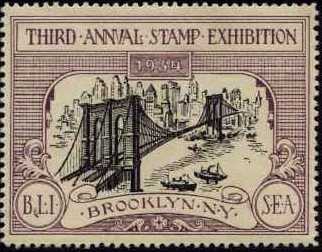

Normal |
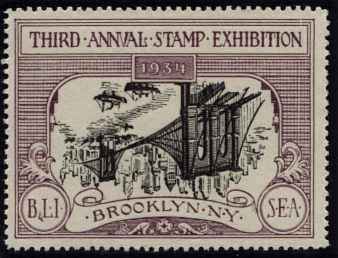

Inverted Centers! |
The Cinderellas
shown above reveal that collectors have a sense of humor, and are willing to poke fun
at themselves, by manufacturing invert "errors" of what are already just imitations of
stamps. Philatelic exhibition seals like these
were very popular during the 30's, and
were issued in conjunction with most large exhibitions.
The Pan-Am Inverts
The Pan-American Exposition stamps were issued in conjunction with the The Pan-Am Expo in Buffalo, NY, in 1901. The Expo had been planned for 1900, to celebrate the new century, but delays made the promoters put it off a year. Since the Expo had been organized with the support and approval of the US governmment, it was only natural that special stamps should be issued to advertise it, as they had been for the World's Columbian Expo in Chicago in 1893, and the Trans-Mississippi Expo in Omaha in 1898. To give the stamps added appeal, they were printed in two colors, which had been done only once before on US stamps, and had to be "sold" to the Bureau of Engraving and Printing, against their vigorous objections, as a way of proving their "artistic craftsmanship".
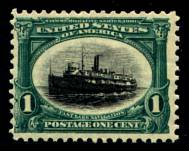
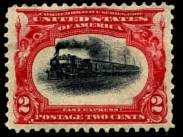
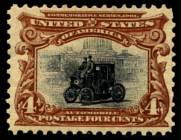
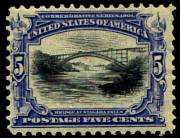
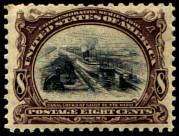
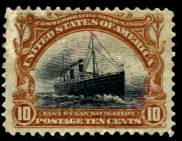
Scott 294-299, issued May 1, 1901
Shortly after the stamps shown above were released on May 1, 1901, reports of inverts popped up all over the country, and for months were the rage of conversation among collectors and fortune seekers. When the dust settled, 250 of the 1¢ stamp, and 150 of the 2¢ stamp with inverted centers had been found. The USPS, feeling left out, printed several hundred copies of the 4¢ stamp in invert form, half with "Specimen" overprint, but some without. These were supposed to be for postal archives, as "reference copies," but about 250-300 of the 4¢ inverts, with and without the overprint, have filtered out into the marketplace. Today the three Pan-Am Inverts shown below catalog $22,500, $50,000 and $85,000 respectively.
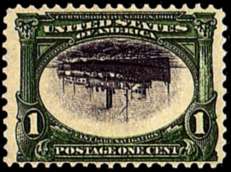
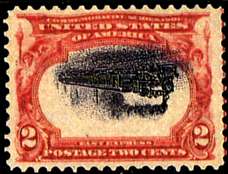

Scott 294a, 295a, 296a
In 2001, the USPS "reissued" the Pan-Am inverts on a "souvenir sheet".
Click here to see more.
The CIA Invert

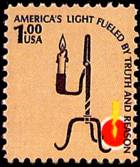
Scott 1610 and 1610c, issued July 2, 1979
It's technically the brown intaglio that is inverted, since it was printed last, but descriptions of inverts generally give preference to the frame or major design elements, so this is described as "flame inverted" by most people. The only known pane of 100 was bought by a CIA employee, on an errand for his office, at a post office in Virginia. Recognizing that what he had might be valuable, but not sure how to capitalize on his find, and presumably short of cash, he enlisted some co-workers to contribute enough money to buy another pane to replace the first one. They had enough brains and patience among them to find a knowledgeable stamp dealer with the resources to purchase most of the pane - each kept one stamp as a "souvenir".
When the story got out, their employer demanded the return of the stamps, and the employees who refused to surrender their stamps were fired. Postal Inspectors tried to retrieve the rest of the pane from the dealer, but since the pane had been purchased legitimately from a clerk at a post office, the sale was legal, and the stamps remained in the philatelic marketplace. Today they catalog only $17,500 apiece. Considering that there are no more of these than the Inverted Jenny, it may seem odd they are worth a tiny fraction as much. I attribute it to the somewhat unattractive appearance of the invert. A plane flying upside down is far more dramatic and appealing than this.
The Nixon Invert
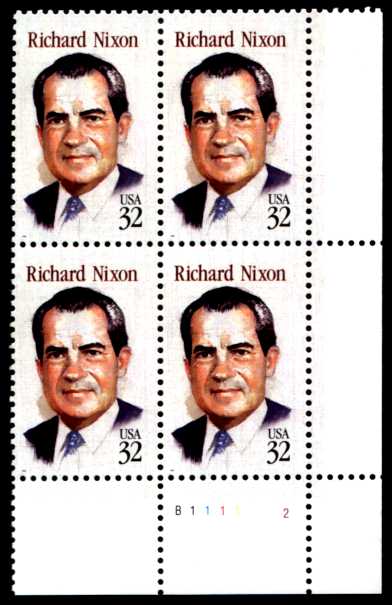
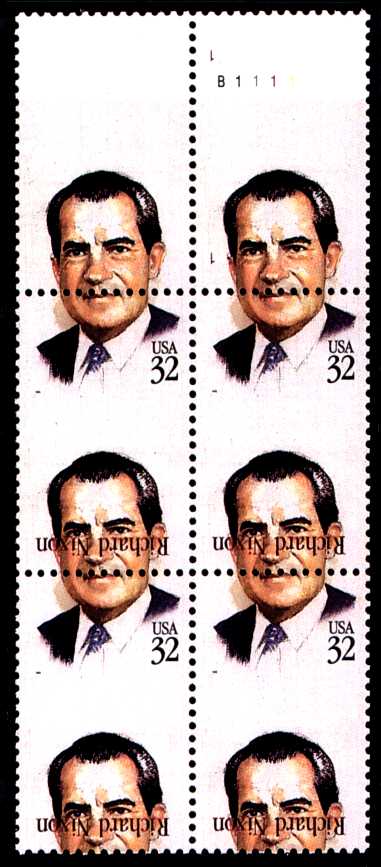
Scott 2995 and "invert error," issued April 26, 1995
On April 26, 1995, one year after his death, and in accordance with a well-established tradition, the USPS released a commemorative stamp for Richard M. Nixon. The following February, invert errors of this stamp started showing up in auctions and among stamp dealers. A total of 160 examples were reported, and the reaction ranged from delight to incredulity. Inverts are always big news among stamp collectors, and usually command high prices, but various elements of the story behind the stamps were suspicious. The first ones sold at auction realized $14,500 each, and that seemed a reasonable value, based on what was known at the time. Many more were sold at similar prices.
By the end of the year, a man named Clarence Robert Robie, a former employee of the plant where the Nixon stamps had been printed, was on trial for "theft of government property", on charges he had stolen the stamps from a trash bin, and smuggled them out of the plant. It turned out they were "printer's waste", and on their way to be destroyed when he pilfered them. Moreover, the US Postal Inspectors, armed with warrants, were tracking down and confiscating all the "errors". Unlike the case of the CIA Inverts, whose sale was legitimate, these stamps had reached the market illegally, and had to be surrendered.
The story of the Nixon Inverts is ironic in two ways - first, that it should happen on his stamp; and second, that the man responsible should be named Robie (the man who bought the Inverted Jennys was named Robey).
Seaway Invert
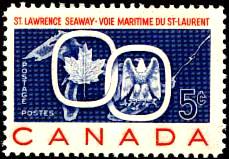

Scott 387 & 387a, issued 6/26/59
The most famous Canadian Invert Error is the stamp on the right above, which occurred on
the 1959 Joint Issue of the US and Canada, to
commemorate the opening of the Saint Lawrence Seaway. The US issue, which has the same
design and colors, was produced on a press that printed both colors at the same time, so
there was no possibility of an Invert Error, but the Canadian stamp was produced in two
passes, and about 400 copies like the one above reached the marketplace. Its current (2019)
catalog value is $9,500.
Inverted Jenny tête-bêche pair - Incredible!

Finally, on display here for the first time, an incredible rarity,
the unique
tête-bêche pair of inverted Jenny with ordinary stamp.
It's provenance is
impeccable (I made it myself).
NOT AN INVERT
9/1/06 - When I was a kid (back in the Dark Ages - the 1950's),
the "World's Most Famous Stamp" was the British Guiana One Cent Magenta.
It was certainly the most valuable stamp at that time - it had last sold, in 1940, for $45,000.
But when I first published this page, in 1997, it had not been on the market since 1980,
when it sold for $980,000,
and some of its competitors for that distinction - the Swedish Three Skilling Yellow, and the
"Z Grill",
had far surpassed it. So until
John du Pont,
its then-current owner, got out of the loony bin, or, as it happened, died, the Penny Magenta
had lost its title.
In 2010, DuPont died, and for several years there was speculation about the fate of the stamp, but finally in 2014 it was on the market again, and finally sold, for a new-record $9.2 million, making it once again the world's most valuable stamp, and probably the most valuable item on the planet by weight.
Like those other famous stamps, the One-Cent Magenta is surrounded by lots of fascinating lore. This Smithsonian NPM web page provides an excellent timeline of the stamp.
A FOOTNOTE: One story I heard recently that hasn't reached the press before concerns the stamp's widely heralded display at a major philatelic exhibition in 1956. Kenneth Pollock, a collector and philatelic writer sent it to me.
At FIPEX {Fifth International Philatelic Exhibition}, which was held at the NY Coliseum, lots of hoopla was being paid to the displaying of the "World's Rarest Stamp"--the British Guiana 1¢ magenta, which had just sold to an anonymous buyer for $50,000. J and H Stolow supposedly managed or cared for the stamp. The managing director of Stolow was a guy named Finbar Kenny(or Kenney).
My Dad and I went up a fancy ramp surrounded by guards to look at the stamp under some big piece of glass, and my dad said: "That is not the stamp. That is a copy." He told me that he had seen and examined the stamp in the early 1930's when he was the Director of the 1934 National Stamp Exhibition. He walked over to Finbar Kenney with me in hand and told Mr Kenney that the stamp was not real. Mr Kenny laughed, saying... "Gene, you're absolutely correct, I have it in my pocket. We were afraid it was going to be stolen, so we are using a copy." He said he would show it to me later, but as I recall, I did not get a chance to see it in person.... This was 50 years ago, but I was very impressed with my Dad.
Thanks, Ken, that's a great story.
There are many more inverts from postal issues of the rest of the world.
In 2002
Shreves Philatelic
Galleries held its sale of the fabulous
Peter Balner Collection of Inverted Centers of the World in NYC.
This was a once-in-a-lifetime opportunity to see so many famous inverts at one time.
The entire auction catalog, with every lot illustrated, is still online at http://stampauctionnetwork.com/f/f52.cfm.
Oddly, the sale did NOT include an inverted Jenny, and there are probably other omissions,
but it is still an
incomparable offering.
| Home | H is for Handstamp <<< | Contents | >>> J is for Joint Issue | Credits |
All Letter images Copyright © 1997, 2000, SF chapter of AIGA
All text Copyright © 2000, 2019, William M. Senkus
Send feedback to the webmaster: CLICK HERE
Revised -- 03/24/2007
Revised -- 08/11/2019

